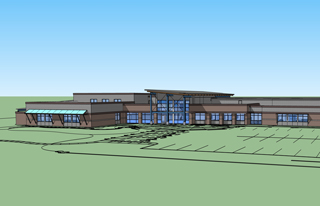|
Subscribe / Renew |
|
|
Contact Us |
|
| ► Subscribe to our Free Weekly Newsletter | |
| home | Welcome, sign in or click here to subscribe. | login |
Construction
| |
 |
August 23, 2012
Skills centers making inroads in Washington
Architects West

Knoll
|
A recent educational trend in Washington is the rapid expansion of skills centers.
Long thought of as secondary options for high school students struggling in the classroom, these centers have dispelled such misconceptions by providing educational and economic impacts in our region.
The first skills center opened in Washington in 1966. It was the sole skills center for a decade, then seven skills centers opened across the state between 1975 and 1985.
In the last 10 years, four new skills centers have been added, serving 39 school districts. Currently, there are a total of 13 skills centers in Washington serving 120 school districts.
A growing role
The evolution of skills centers has been remarkable. The education system in recent years has experienced a paradigm shift away from a mentality that all students should strive to complete a traditional higher-education degree in order to be successful.
As the education system begins to recognize the benefits that workforce training provides and the demand for these skills, the important role of skills centers has surfaced. Skills centers now provide the technical training necessary for all students to experience success and apply them as a first-choice track.
“Walk through the halls of a skills center and you will see all different students, from straight-A students traditionally targeted for a four-year university, to those who struggle in a traditional classroom,” said Gerry Ringwood, director of the Tri-Tech Skills Center in Kennewick.
The state Legislature has been a strong proponent of skills centers as economic and educational drivers. In the 2012 capital budget, over $56 million was appropriated to skills center construction. This money is being used to create new branch skills centers aimed at providing access to high-quality workforce training in areas currently not being served by other skills centers.
Job training
Growth has been exponential, with the Legislature enacting a jobs-stimulus bill this year that introduced what state Sen. Jim Kastama has called “smart-ready” projects: projects that lower construction unemployment and result in buildings that train future workers once they are complete. That’s in contrast to “shovel-ready” projects from the 2009 federal stimulus bill that briefly decreased construction unemployment but had no lasting employment impact after the projects were completed.
Skills centers and higher-education professional/technical centers have gained attention because they exist to train individuals in fields ranging from construction and manufacturing to nursing and veterinary medicine.
The key educational difference skills centers provide is versatility. Every skills center is different, with programs focused on the needs of the region they serve and the state as a whole.
“The ability to provide access to high-quality training that leads to immediate employment opportunities or advanced training is the fundamental mission of skills centers,” Ringwood said.
In-demand programs
With the goal of training students to be capable of entering the workforce immediately, it is important to offer programs in demand for the communities served.
One example of this demand-focused curriculum is the aerospace industry. Currently, there are 650 companies in Washington associated with the aerospace industry. This high-demand market is also lacking in qualified skilled laborers in fields such as aerospace manufacturing.
This need has been recognized in Spokane Valley, where design work is under way on a building that will house programs for aerospace manufacturing and other job fields. It will serve as a branch campus for the Newtech Skills Center. The branch campus is a cooperative effort of four Spokane Valley-area school districts, led by the Central Valley School District.
“It appears aerospace jobs will continue to grow statewide for the next five to 10 years,” said Ben Small, superintendent at the Central Valley School District.
“Spokane in particular is doing a lot to draw more aerospace jobs in the region that will supply living-wage jobs and allow our students to stay in the area and be successful.”
As trends continue and new employment opportunities rise to the surface and others fade in demand, skills centers evolve as well by offering new programs to meet the needs of employers. This presents a unique challenge in the design and construction of such facilities.
“You’re not just designing to meet the needs of the client today, but instead developing a building that is capable of serving needs well into the future that we can only speculate what those needs might be,” said Kevin Cole, project architect with Architects West.
Cole is the lead designer of the 36,000-square-foot Southeast Area Washington Technical Skills Center in Walla Walla. The branch skills center recently received funding for construction, and contract bidding will begin in September.
Flexible space
The key design components for these facilities include abundant infrastructure, sound control and flexible space configurations. Maximum flexibility allows programs to adapt quickly and remain on the leading edge of workforce training. In order to provide that flexibility, spaces must have infrastructure located throughout to meet the potential future need.
Sound protection between spaces is important as well. Some programs use noisy equipment, and that noise needs to be contained in the space it serves in order to keep from disrupting other programs.
While the state Legislature and education system have begun to acknowledge the value of skills centers, the general public has been slower to understand the high level of training provided, due mostly to a lack of understanding of how skills centers have evolved over the last 50 years.
“I implore everyone to go visit your local skills center, and do it when students are there,” said Ringwood of the Tri-Tech Skills Center in Kennewick.
“The most common response I hear from people is the surprise that high school students have access to this high level of equipment and training from such qualified instructors with workforce experience.”
As long as skills centers retain their ability to read and react to the needs of the state and local communities, they will continue to be enormously positive contributors to the educational and economic success of Washington.
Matt Knoll is the client development director for Architects West. He has nine years of experience in both the construction and architecture industries.
Other Stories:
- 5 tips to help districts with their long-range plans
- School contractors face new scrutiny from taxpayers
- UW’s Mercer Court aims to keep students socially connected
- Schools can stretch facilities budgets by embracing technology
- Laser scanning: a powerful tool for school projects
- Portables aren’t the last word in modular schools
- Schools face pressure to keep up with tech trends
- Online learning will have lasting effect on campus spaces



